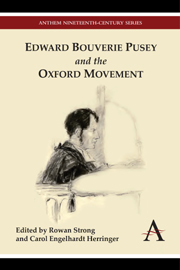Book contents
- Frontmatter
- Contents
- Acknowledgements
- Notes on Contributors
- Chapter One Introduction
- Chapter Two The History of the History of Pusey
- Chapter Three Editing Liddon: From Biography to Hagiography?
- Chapter Four From Modern-Orthodox Protestantism to Anglo-Catholicism: An Enquiry into the Probable Causes of the Revolution of Pusey's Theology
- Chapter Five Defining the Church: Pusey's Ecclesiology and its Eighteenth-Century Antecedents
- Chapter Six Pusey's Eucharistic Doctrine
- Chapter Seven Pusey, Alexander Forbes and the First Vatican Council
- Chapter Eight Pusey and the Scottish Episcopal Church: Tractarian Diversity and Divergence
- Bibliography
- Index
Chapter Five - Defining the Church: Pusey's Ecclesiology and its Eighteenth-Century Antecedents
Published online by Cambridge University Press: 05 April 2013
- Frontmatter
- Contents
- Acknowledgements
- Notes on Contributors
- Chapter One Introduction
- Chapter Two The History of the History of Pusey
- Chapter Three Editing Liddon: From Biography to Hagiography?
- Chapter Four From Modern-Orthodox Protestantism to Anglo-Catholicism: An Enquiry into the Probable Causes of the Revolution of Pusey's Theology
- Chapter Five Defining the Church: Pusey's Ecclesiology and its Eighteenth-Century Antecedents
- Chapter Six Pusey's Eucharistic Doctrine
- Chapter Seven Pusey, Alexander Forbes and the First Vatican Council
- Chapter Eight Pusey and the Scottish Episcopal Church: Tractarian Diversity and Divergence
- Bibliography
- Index
Summary
Theories about the true character of the church presented a major challenge to the Tractarians. They wanted to determine the church's nature, its authority and its relationship to secular powers. Yet they were not the first to attempt this: this concern cropped up often within the Church of England, looking at itself in connection to other branches of Christianity and at its unique position as the established church in England in relation to the dissenting sects. This apprehension especially arose during the period from the Glorious Revolution to the accession of the Hanoverians. Here too debates over ecclesiology raged in the pamphlet press. In many respects, these two periods – from the Glorious Revolution to the Hanoverian Succession, and from the repeal of the Test and Corporation Acts to the departure of Newman to Rome – exhibit a number of interesting parallels. Specifically, these periods show that high ecclesiology arose at times when the church saw itself threatened.
In his excellent work, The Oxford Movement in Context, Peter B. Nockles presents a portrait of the relationship between the High Churchmen and the Tractarians. While he demonstrates the continuity between the High Church tradition in the eighteenth century and the Tractarians, he focused on the period after 1760, a relatively quiescent period. As Owen Chadwick has pointed out, however, questions about the nature of the church escalate when its defenders perceive outside or internal threats.
- Type
- Chapter
- Information
- Edward Bouverie Pusey and the Oxford Movement , pp. 67 - 90Publisher: Anthem PressPrint publication year: 2012



